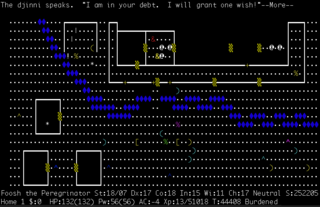
NetHack is an open source single-player roguelike video game, first released in 1987 and maintained by the NetHack DevTeam. The game is a fork of the 1982 game Hack, itself inspired by the 1980 game Rogue. The player takes the role of one of several pre-defined character classes to descend through multiple dungeon floors, fighting monsters and collecting treasure, to recover the "Amulet of Yendor" at the lowest floor and then escape.

Roguelike is a style of role-playing game traditionally characterized by a dungeon crawl through procedurally generated levels, turn-based gameplay, grid-based movement, and permanent death of the player character. Most roguelikes are based on a high fantasy narrative, reflecting their influence from tabletop role-playing games such as Dungeons & Dragons.
Ancient Domains of Mystery is a roguelike video game designed and developed by Thomas Biskup and released in 1994. The player's goal is to stop the forces of Chaos that invade the world of Ancardia. The game has been identified as one of the "major roguelikes" by John Harris.
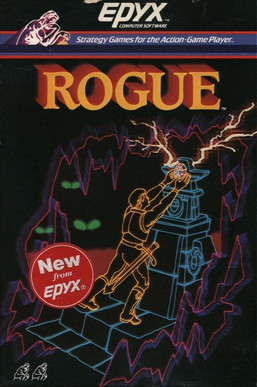
Rogue is a dungeon crawling video game by Michael Toy and Glenn Wichman with later contributions by Ken Arnold. Rogue was originally developed around 1980 for Unix-based minicomputer systems as a freely distributed executable. It was later included in the Berkeley Software Distribution 4.2 operating system (4.2BSD). Commercial ports of the game for a range of personal computers were made by Toy, Wichman, and Jon Lane under the company A.I. Design and financially supported by the Epyx software publishers. Additional ports to modern systems have been made since by other parties using the game's now-open source code.
Crawl, The Crawl, or crawling may refer to:
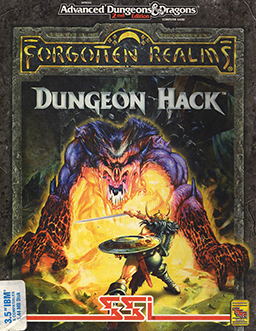
Dungeon Hack is a 1993 role-playing video game developed by DreamForge Intertainment and published by Strategic Simulations for DOS and NEC PC-9801.

In computing, procedural generation is a method of creating data algorithmically as opposed to manually, typically through a combination of human-generated content and algorithms coupled with computer-generated randomness and processing power. In computer graphics, it is commonly used to create textures and 3D models. In video games, it is used to automatically create large amounts of content in a game. Depending on the implementation, advantages of procedural generation can include smaller file sizes, larger amounts of content, and randomness for less predictable gameplay. Procedural generation is a branch of media synthesis.

pedit5, alternately called The Dungeon, is a 1975 dungeon crawl role-playing video game developed for the University of Illinois Urbana-Champaign's PLATO computer network by Rusty Rutherford. In it, the player controls a character exploring a fixed, single-level dungeon containing randomly-generated monster encounters and treasure. When they encounter a monster, they can fight the monster with a weapon or spells, or attempt to flee. Characters can be saved between sessions.

DRL, short for Doom, the Roguelike, is a roguelike video game developed by ChaosForge based on the first-person shooters Doom and Doom II. It has been in development since 2002, and was released for Microsoft Windows, Linux and OS X. Following a cease and desist notice from "Doom" trademark owner ZeniMax Media, the game's name was changed to DRL in 2016.
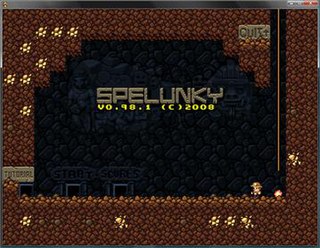
Spelunky is a 2008 source-available 2D platform game created by independent developer Derek Yu and released as freeware for Microsoft Windows. It was remade for the Xbox 360 in 2012, with ports of the new version following for various platforms, including back to Microsoft Windows. The player controls a spelunker who explores a series of caves while collecting treasure, saving damsels, fighting enemies, and dodging traps. The caves are procedurally generated, making each run-through of the game unique.

DarkSpyre is a 1990 video game produced by Event Horizon Software for MS-DOS. It was released the following year for the Amiga. Darkspyre is a dungeon crawl style role-playing game. It uses top-down graphics and randomly generated dungeons, similar to a roguelike.
Elona is a single-player, roguelike game developed by Japanese developer Noa; it was released in August, 2007.
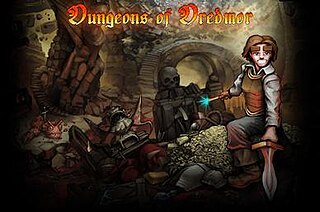
Dungeons of Dredmor is a roguelike indie video game released on July 13, 2011, by Gaslamp Games. A downloadable content (DLC) pack, "Realm of the Diggle Gods", was released later that year. A second DLC, "You Have To Name The Expansion Pack", was released on June 5, 2012, and a third, "Conquest of the Wizardlands", was released on August 1, 2012. The game has extensive support for user-created modifications.

Desktop Dungeons is a single-player roguelike-like puzzle video game developed and published by QCF Design. Released in November 2013, the game underwent a lengthy public beta phase, during which it was available to customers who pre-ordered the game. In the game, players navigate a dungeon filled with monsters before battling a final dungeon boss. The game has qualities of a puzzle as players must find the best methods to use items, spells, and upgrades to reach the final boss without losing too much of their character's health. Desktop Dungeons has been compared to a roguelike but with condensed gameplay. Desktop Dungeons received an award for Excellence in Design at the 2011 Independent Games Festival. The game is available for Windows, Mac, Linux, iOS, and Android. A video game remake titled Desktop Dungeons: Rewind was announced in 2022 and released April 18, 2023.
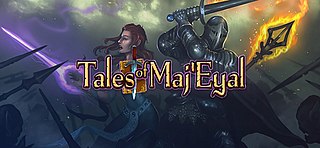
Tales of Maj'Eyal is an open-source roguelike video game released for Microsoft Windows, Mac OS X, and Linux in 2012. Tales of Maj'Eyal is available as donation-supported freeware (donationware) from the developers; donations grant some exclusive online features as part of a freemium model. The game may also be purchased through the digital distribution outlets Steam or GOG. The game's TE4 game engine source code is under a GNU GPLv3 license, while the game's assets are licensed for use "with the Tales of Maj'Eyal game only".
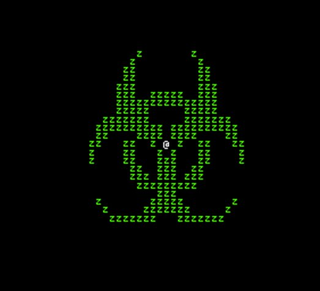
Cataclysm: Dark Days Ahead (CDDA) is an open-source survival horror roguelike video game. Cataclysm: Dark Days Ahead is a fork of the original game Cataclysm. The game is freely downloadable on the game's website and the source code is also freely available on the project's GitHub repository under the CC BY-SA Creative Commons license. The game is currently largely developed by its community. Rock, Paper, Shotgun named CDDA one of "The 50 Best Free Games on PC" in 2016.

Crawl is a brawler indie game by Australian developer Powerhoof. Up to four players and bots in local multiplayer advance through randomly generated dungeons with one player as the hero and the others as spirits who possess traps and monsters in the environment to kill and thus replace the hero. The game received a Steam Early Access release for Microsoft Windows, OS X, and Linux platforms in August 2014, and a full release for those three as well as PlayStation 4 and Xbox One in April 2017 and a release for Nintendo Switch on December 19, 2017.
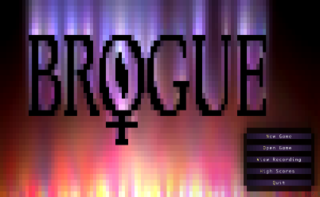
Brogue is a free roguelike computer video game created by Brian Walker. As in its predecessor Rogue, the goal of Brogue is for the player to descend to the 26th floor of the Dungeons of Doom, retrieve the Amulet of Yendor, and return to the surface. Players also have the option of delving deeper into the dungeon to obtain a higher score. This task is complicated by the presence of monsters and traps in a procedurally generated dungeon.
A roguelike deck-building game is a hybrid genre of video games that combines the nature of deck-building card games with procedural-generated randomness from roguelike games.

Mistover is a 2019 roguelike dungeon crawler role-playing video game developed and published by Krafton for Microsoft Windows, Nintendo Switch, and PlayStation 4. Mistover is set in a ravaged world recovering from a mass invasion of monstrous creatures from another realm, and its storyline follows the journey of a party of adventuring heroes who are on a quest to discover the source of the invasion. Players navigate environments from an isometric perspective with a party of procedurally generated player characters drawn from a roster of eight character classes to fight monsters and acquire loot recovered from the exploration of levels. A phenomenon known as "mist" is prevalent throughout the game world and negatively influences its characters, monsters, and items.



















